#Ibaloi
Explore tagged Tumblr posts
Text

ibaloi miku ^_^
460 notes
·
View notes
Text


A bust of Mateo Cariño (top) and a photograph of him on a horse (bottom).
Born in 1841, Mateo Cariño ruled the land that is now known as Baguio. He was given the title over this land by the Spanish in return for his conversion to Christianity after which he adopted the name Cariño. During the American colonial period, he allegedly provided refuge for President Emilio Aguinaldo - an act which caused American authorities to issue a confiscation of his lands. He died in 1908, a year before his posthumous legal victory in the Cariño v. Insular Government case.
5 notes
·
View notes
Text

This is Lola Miguela in her teenage days. Now, she just celebrated her 100th birthday!
If she's being asked what is her secret, she always answers that there's no secret! It was all God's gift. So embrace your gifts. Note: Lola is a term used by Filipinos to refer to their grandmothers.
0 notes
Text

Nu waday watwat, wada kas di.
Either for atonement or thanksgiving, Cañao is done in the Cordilleras wherein an animal/animals is/are butchered as an offering to Kabunian or other spirits having reached divine status. And since it is for the divine, it must be cooked basically plain and pure that some tribes even skip the use of salt not until the offering ritual is done. It is then feasted on by the community with the meat distributed as "watwat".
Throughout time and with the assimilation of other cultures, this watwat form of serving has become a delicacy modified with minimal addition of seasonings and veggies.
#watwat#kiniing#kinuday#igorot#cordillera#torogi#ibaloi#baguio#benguet#mountain province#kakana-ey#kalanguya#bontoc#indigenous#delicacy#foods
0 notes
Photo
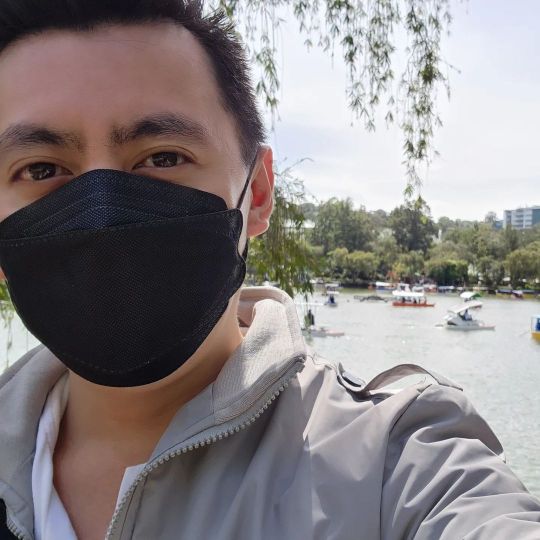
TARA SA #BurnhamPark dito lang sa #BaguioCity Best place para mag #Date kasama #boyfriend or #girlfriend, #Friends or #Self Maraming #foods, #milktea, #juice, #skating #biking or #loving loving sa gilid gilid Follow me on Instagram: Instagram.com/TheStoryofAnthony #burnham #sabaguio #baguio #ibaloi #kankanaey #igorot #igorotak #baguiofeels #baguioweather #coldweather (at Burnham Park, Baguio) https://www.instagram.com/p/Cod84suAl4R/?igshid=NGJjMDIxMWI=
#burnhampark#baguiocity#date#boyfriend#girlfriend#friends#self#foods#milktea#juice#skating#biking#loving#burnham#sabaguio#baguio#ibaloi#kankanaey#igorot#igorotak#baguiofeels#baguioweather#coldweather
0 notes
Text
High-Tech Rescue for the Kabayan Mummies in the Philippines
Ancient Kabayan "fire" mummies in Luzon, Philippines, face risk from environmental changes. Researchers use modern technology to study and preserve these Ibaloi ancestral remains.
via University of Melbourne/Phys.org, 23 January 2024: The Kabayan “fire” mummies, located in Luzon’s northern mountains, Philippines, are a testament to an ancient mummification tradition practiced by the Ibaloi people. Dating back to 200 BC, these mummies are now at risk due to environmental changes and deterioration. In 2023, a research team from the University of Melbourne, supported by the…
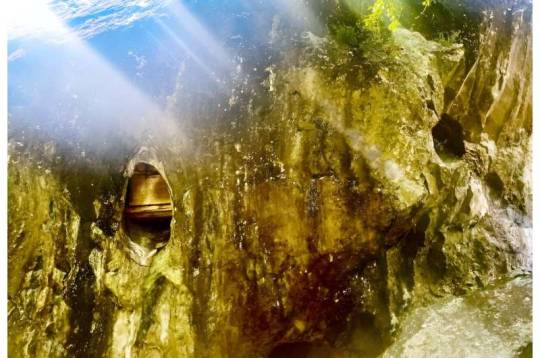
View On WordPress
0 notes
Text
This link has 250 Mikus approximately
I will add as I find them 50 more here
Indian Miku
Indian Miku
Andhra Pradesh Miku
Bengali Miku
Chinese Miku
Southeast Asian Chinese Miku
Chinese Grandma Miku
Chinese and Bengali Miku
Ecuadorian Miku
Guatemalan Miku
Turkish Miku
Pontic Greek Miku
Ibaloi Filipino Miku
Peruvian Miku
Vietnamese Miku
Bahamanian Miku
Canary Islander Miku
Ukrainian Miku
Ukrainian Miku
Ukrainian Mikolaiv Miku (Mikulaiv?)
Ternopil and Tula oblast Mikus
Aragonese Miku
Mi'kmaw Miku
Czech Miku
Jewish Miku
Moroccan Jewish Miku
Polish Miku
Polish Miku
Polish Miku
Sarmatian Sarmacka Miku
Opoczno Miku
Krakowska Miku
Lubelska Polish ale Miku jest zajebista
Polish Lubuskie Miku
Polish Poznań Miku
Polish Kaszubska Miku
Polish Podlasie Miku (Mine)
Sorbian Miku
Southern Udmurt Miku
Moldovan Miku
Papuan Miku
Omani Miku
Kazakh Miku
Latvian Miku
Italian Piedmontese Miku
Bośnian Miku
Angolan and Mozambik Miku
Viljandi Estonian Miku
Kyrgyz Miku
Algerian Miku
Mexican Miku
Ojibwe Miku
Canadian Miku
Armenian Miku
Ghanaian Miku
French Miku
Dutch Miku
Chicana Miku
Andalucían Miku
Catalán Miku
Spanish Miku
Russian Miku
Palestinian miku
Burmese Miku
Portuguese Miku
Portuguese Miku
Portuguese Miku
Serbian Miku
Guadeloupean Miku
French Guianan Miku
St Kitts and Nevis Miku
Lombard Miku
Etruscan Miku
Bułgarian Miku
Croatian Miku
Valenciana Miku
Vietnamese Miku
Māori Miku
Māori Miku
Malagasy Miku
Scottish Miku
Welsh Miku
Peranakan Miku
Filipino Miku
Filipino Miku
Icelandic Miku
Icelandic Miku
Sakhalin Miku
Moroccan Berber Miku
Lakota Miku
Boliviana Miku
Puerto Rican Miku
Muscogee Creek Miku
Austrian Miku
Nigerian Miku
Romanian Miku
Turkmen Miku
Moroccan Miku
South African Miku
399 notes
·
View notes
Text
still thinking about filipinos in the fallout wasteland, but now in the context of my headcanon that fallout america annexed the philippines in 1946 instead of granting the nation its independence.
what made me think of this headcanon? the timeline between our world and the fallout world splits at about that period, and, well, there's precedent for the annexation: in real life, there were 50 years of american occupation, and there's ongoing american intereference in our politics, economy, and culture (essentially making the philippines an american neo-colony, but i digress), and considering how fallout america is just america turned up to 11, these things will just be magnified, and so: the philippine annexation of 1946.
now, there's nothing in fallout canon about the philippines except for a brief off-hand comment from the newscaster at the beginning of fallout 4 about american troops in mambajao (an island in camiguin) but this already tells me that, by 2077, if american military presence in the philippines has managed to reach that part of mindanao, the american occupation has intensified.
that little nugget already paints such a vivid picture of what's happening in fallout philippines - an american military base in mindanao tells me that more indigenous communities were displaced (real life example: the aeta and ibaloi communities in luzon, who still, to this day, cannot return to their ancestral lands), that sexual exploitation of women and children was rampant (irl: the sex industry in angeles city, among other areas), that american soldiers were free to enact violence on filipinos without facing any consequences (irl: jennifer laude's murder at the hands of joseph pemberton), that american imperialism is thriving in the archipelago, and that the sino-american war is serious and ramping up.
but let's see what the newscaster actually says:
"It would also appear our troops stationed overseas are experiencing some unusual weather, as well. On the Island of Mambajao the nights are cold. Unseasonably so for Southeast Asia. But for the 5th Infantry, that's as comfortable as an Autumn jamboree. All the easier for our mechanized hellcats to drive any screaming Commie meanies right into the Bohol Sea."
"screaming commie meanies" tells me that there's a significant communist presence in the philippines, which i am taking to mean that the communist party of the philippines and the new people's army are alive and well and fighting against the american occupation. i really don't think there'd be many chinese communist spies in the philippines at this time since filipino communists are against chinese imperialism as well, but tbh this part isn't solidified in my brain as much... anyway
essentially, fallout philippines has the problems of current, real life philippines, just amplified. american occupation on one hand, chinese imperialism on the other, unusual cold weather (which tells me that climate change was also a problem in the fallout universe), the threat of nuclear war... all with ordinary filipinos in the middle. would it be a stretch to say that a lot of them fled to america and established their own communities there? that those communities would have thrived and retained our creativity and sense of community/pagkakapwa abroad? that those communities would have survived the bombs and banded together and kept themselves and their culture alive, in the apocalypse?
#shh peri shhh#philippine politics? in my fallout game? it's more likely than you think#i haven't even gotten into the poverty and corruption that would've been rampant in an annexed philippines since america would likely#take our natural resources and land for themselves (as it's doing right now; see what americans are doing to siquijor)#but this is too much already lmao
83 notes
·
View notes
Text

ibaloi preserved dead, luzon, philippines in memento mori: the dead among us - paul koudounaris (2015)
51 notes
·
View notes
Text
Painting a picture of the history of Filipino Tattoos
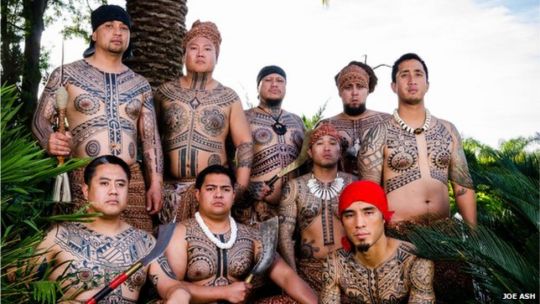
A photo of tattooed Filipino men posted on BBC and accredited to Joe Ash
Tattoos are often seen as integral cultural symbols in my different societies whether it be seen as something honorable or dishonorable. Even in the most straight-laced cultures, a tattoo acts as a mark of some form of the person's history and their standing in their communities as well as how people perceive them.
In a lot of modern cultures, the tattoo often have negative connotations, often associated with delinquency or criminal activity. Historically, however, they may have grander and more honorable significance in different societies. The communities that had existed in the Philippines prior to contact with Spain fits this similar pattern.
Before I start
As usual, the Philippines is a diverse country that has different traditions and histories that come from different ethnic groups and states, only being first unified under a government by colonization. Because of this, this post will only be able to cover parts of this culture and may not be able to fully encompass all Filipino traditions, practices, and beliefs about tattoos.
This is also given the fact that more specific information may be harder to come across or may not exist at all in a space I could easily access.
That being said, the general term for Filipino traditional (both precolonial and current) tattoo practices is batok, batik, patik, or patek depending on language or culture. It is also known as buri or burik in several other groups and languages. This word, however, isn't often used for typical tattooing in most modern communities.
The History
From a general understanding of a lot of precolonial Southeast Asian cultures, it can be assumed that precolonial Filipino societies heavily valued tattoos as their neighboring maritime SEAsian countries also had prior to the introduction of Abrahamic religions to the region which often discouraged or even forbade tattooing the skin.
Although this can be assumed, there were no known precolonial description nor record of these tattoos during the actual time period before Spanish contact. There is evidence found in some burial sites however, as discussed by social anthropologist Salvador-Amores in her paper The Recontextualization of Burik (Traditional Tattoos) of Kabayan Mummies in Benguet to Contemporary Practice (2012). In the paper, she focuses a section on the history of burik by explaining the Kabayan Mummies or the Fire Mummies of Benguet, Mountain Province.
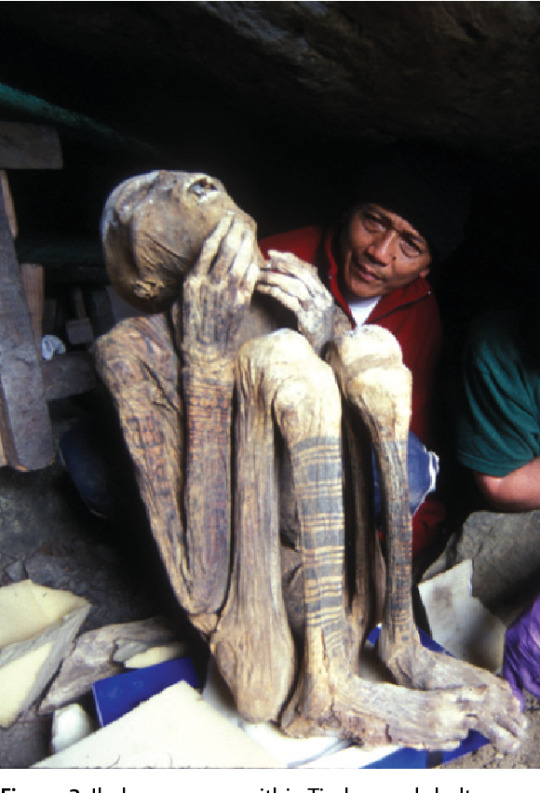
An image of one of the Kabayan Mummies uploaded by Dario Piombino-Miscali on ResearchGate.net
These remains had been dated back to the 13th century and are associated with the Ibaloi, an indigenous ethnic group from Mountain Province found in the northern parts of the island of Luzon. This does confirm that tattooing had been important to the people who had lived in this area during this time period as, in Salvador-Amores's paper, it can be noted that the tattooed mummies seem to be prominent with the adults.
I do have to note that the Ibaloi people, who are part of the larger Igorot ethnic group, were not fully colonized by the Spaniards and therefore does not share the similar Hispanic culture and history that a lot of Filipino groups have. They had only fully been integrated into the Philippines during the American colonial period where they and the other Igorots had been properly colonized by American and placed under the rule of the American-controlled Filipino government. (x)
Regardless, this does show that at least some cultures in the archipelago held tattoos with high importance and did not consider them as something negative compared to the modern perception of tattoos.
The first known illustration of tattooed Filipinos, however, was first seen in the Boxer Codex (circa 1590) during the early Spanish colonial period, written and illustrated by an unknown author.
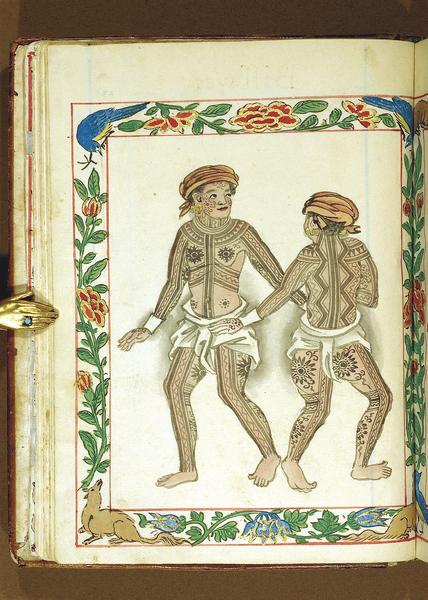
A page from the Boxer Codex (circa 1590), author uknown
This illustration seems to be that of the specific ethnolinguistic group, the Visayans as this page is next to another one labeled as "Biſſaya", a likely earlier spelling of Bisaya that uses the long s (ſ). This aligns with the description given as early as Antonio Pigaffatta, Ferdinand Magellan's chronicler, who consistently describes the Visayans that he has met as painted in his account of their arrival in the islands back in 1521.
The book The Philippine Islands 1493-1898 Vol. XII has compiled different first-hand and second-hand sources about the Philippines during the 15th through 19th century, with Vol. XII focusing on the early 17th century which aligns closely to the Boxer Codex. Within the text, there are several mentions of the "Pintados" or the Painted ones, even having an entire province be called the "province of Pintados".
It isn't made clear who the Pintados are besides the fact that they seem to be hostile towards the Spanish colonizers and had often fought battles with one of the letters even claiming that they had poisoned one of the Spaniards. It isn't until we reach the last part of the compilation which features Pedro Chirino's Relacion de las Yslas Filipinas which I had a hard time finding before but had now found a free and accessible copy. Within Chirino's writing, he explains that the Pintados seem to be a name given by the Spaniards to the Bisayans and further explains it as such:
"The people of the Bisayas are called the Pintados, because they are actually adorned with pictures --not because this is natural to them, although they are well built, of pleasing countenance, and white; but because they adorn their bodies with figures from head to foot, when they are young and have sufficient strength and energy to suffer the torment of the tattooing; and formerly they tattooed themselves when they had performed some act of valor."
Chirino even gives an explanation as to how precolonial Visayans tattooed their skin:
They tattoo themselves by pricking the skin until the blood comes, with sharp, delicate points, according to designs and lines which are first drawn by those who practice this art; and upon this freshly-bleeding surface they apply a black powder, which is never effaced. They do not tattoo the body all at the same time, but by degrees, so that the process often lasts a long time; in ancient times, for each part which was to be tattooed the person must perform some new act of bravery or valiant deed
It is notable, however, that not only did the Spanish not mention any tattoos on other Filipino groups such as the Tagalogs, but a lot of the illustrations in the Boxer Codex do not sport any tattoos at all which makes it confusing as to when had tattoos faded out of cultural significance in these other communities, likely even before Spanish contact.
Lane Wilcken, a researcher who studies the history of tattoos from the Philippines and the Pacific Islands, writes in his book Filipino Tattoos: Ancient to Modern (2010) that it may be possible that the Tagalogs may had lost their tattooing traditions shortly before Spanish contact during the recent islamization of their communities circa 1500 which was and specifically in the polity of Maynila. This may also be the case for the Moros which is a muslim ethnolinguistic group found in the island of Mindanao.
Either way. tattoos became more scarce within Filipino records after the arrival of the Spanish and the introduction of Christianity to the islands, save for some indigenous groups that were not fully colonized by Span like previously mentioned Igorot people.
Because of the spread and dominance of Christian and Islamic customs throughout the country, Batok, as it originally was, was lost to time with the lack of existing artists and cultural relevance tattoos. Tattoos didn't come back to the Filipino mainstream until modern tattoos became more prevalent especially in the mid to late 20th century, similar to its rise in popularity in Western cultures, and even then, it wasn't really what I would consider any traditional and is often negative.
Present Day
Like a lot of other countries, however, tattoos had seen a swing of opinion and is more accepted now as an art form rather than a sign of criminal activity but some stereotypes are still popular.
For instance, during the COVID-19 lockdown, the Department of Education provided modules for students to answer at home which would be then collected by the school from door to door. In one of these modules, Lea Salonga, a Filipino singer, complained on November 17, 2020 on her Facebook page of a discriminatory question that was found in one of the modules, pictured below
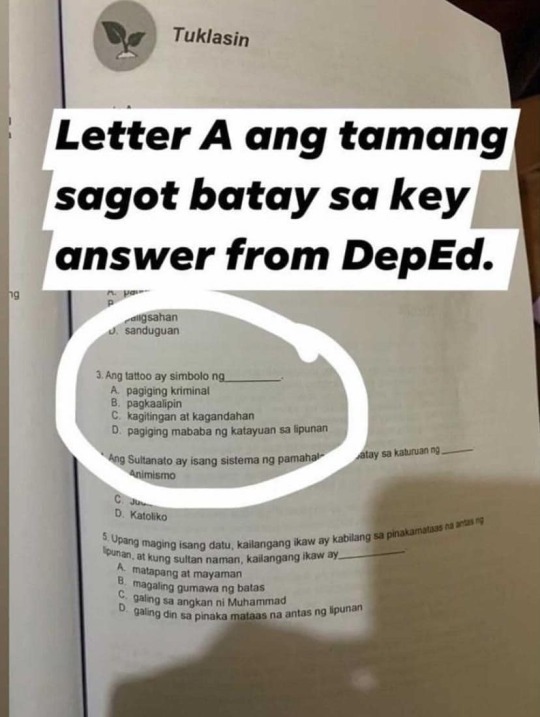
EN Translation:
White text: The answer is letter A based on the DepEd answer key. Module text: 3. Tattoos are a symbol of _____ A. being a criminal B. being a slave C. courage and beauty D. having a low standing in society
This controversy caused an uproar online and showed that there are a lot of Filipinos today that don't see a problem with tattoos and even see them as a positive. Two days after the image was posted on Salonga's page, the Department of Education publicly recognized the misstep and had issued that they officially recognized the controversial answer as an error.
It is important for me to note that, just like in a lot of countries, tattoos are typically not accepted in the corporate world and those who have them either have to get them removed or at least cover them up if they get hired at all. There's still a common idea that people with tattoos, if not dangerous, may be seen as unprofessional or even unclean which I do know is a similar thing that other countries may have as well.
As for batok, its comeback in the larger Filipino mainstream didn't return until some time in the late 2000s and 2010s when more international influence had resparked and interest in more ethnic cultures including the precolonial Filipino tattoos specifically because of the internet and the rise of social media. The current batok that we see outside of indigenous communities could be seen as a recreation of the extinct practices within the Philippines with some level of appropriation from related cultures (by appropriation, I mean this in a neutral way not a negative one).
It is argued whether or not the reconstructed practice could be considered traditional at all, but considering its heavy emphasis on the older designs found in historical illustrations as well as designs from indigenous communities that did not have practice eradicated by colonization, some also argue that the modern tattoos that has gained prominence because of modern technology and research is still valuable in a socio-anthropological sense.
As Salvado-Amore puts it
the successive phases and changes in the status of burik tattoos—enabled by the advent of modern technology, the Internet, and mass media—encourage an interaction between contemporary and historical influences rather than an extinction of past practice.
About Apo Whang-Od
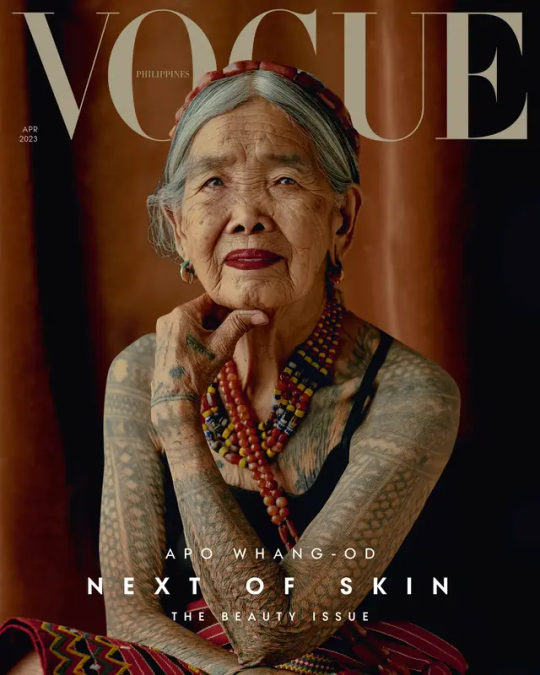
A magazine cover of Vogue featuring Whang-Od, a traditional tattoo artist from the Butbut people, a subgroup within the Kalinga ethnic group. (The rest of this section pulls from the same article by Vogue)
Any research about Filipino tattoos, especially in the modern day would be incomplete without any mention of Whang-Od, the most popular traditional tattoo artist from the Philippines.
Apo Whang-Od (b. February 17, 1917, a.k.a. Maria Oggay) is a member of the Butbut people of the Kalinga indigenous ethnic group from Kalinga province, Philippines. She is often known as one of the last mambabatok in the country which earned her fame and recognition internationally. She started her tattooing practice since she was a teenager at age 16, under the mentorship of her father and was the only known female mambabatok during her time.
For years, she was called on by different communities within her locale in order to tattoo important and symbolic tattoos on members of her and different communities after they had received certain milestones. Men were tattooed for different reasons than women as men were given their marks when they succeed in activities like headhunting, which was ritualistically important for the Butbut people while women were tattooed for reasons like fertility or beauty.
Because of American colonization, however, headhunting was prohibited so she was mostly tattooing women from then onward.
She started gaining recognition some time in the mid-2000s to the 2010s after she started serving foreign tourists, although she doesn't give them the more traditional symbols. Non-members of the group are given a set of tattoos that she could tattoo on anyone without any strong connection to the original meaning of the art.
Since tattooing was passed through family and Whang-Od herself didn't had any children, she was known as the last mambabatok for a time which caused concern for the extinction of the practice as she was already in her 90s when she gained notoriety, but she has since started training her grandniece Grace Palicas and later on her other grandniece Elyang Wigan and the two, who are now in their 20s, has since helped their great aunt dealing with their clientele.
Due to her fame, she is often the subject of foreign media and interest, even being invited by Vogue magazine to pose for one of their covers (pictured above) and is now known as the oldest Vogue cover model earlier this year at the age of 106.
Despite her fame and arguably cultural importance to not only the Kalinga people but the Philippines as well as online petitions since the 2010s to give her the recognition, she is not eligible to receive the National Artist award— one of the highest awards given to artists of most artistic fields of which only 81 people had received. Victorino Manalo, Chairman of the National Commission for Culture and Arts (NCCA) explains that this is because her craft, tattooing, isn't covered by the NCCA but by the Gawad sa Manlilikha ng Bayan (GAMBA, en. Award for Crafters/Creatives of the Nation) but there has been some discussion within the commission about this issue which still ended with her being denied. In light of this, she is now currently on the running to possibly receive the GAMBA award.
She has an online presence managed by others and she can be found via Facebook and Instagram.
Tattoos now, from my experience
As I had said before, tattoos these days are not as negatively seen as they were in the 20th century and had received a more positive reputation thanks to the rise of its social experience due to the internet and social media's prevalence in the country. As an art student, in fact, it's wasn't that surprising when I learned that one of my classmates had a tattoo and it was even a full sleeve! Now, as least three had tattoos before they graduated with one of them actually being a close friend of mine who's planning to get more despite their parents' disapproval.
Despite this, I still do have people in my life right now that see tattoos as undesirable and unclean, with stereotypes still being prevalent. I had once heard people speak of them in such a negative way but then make an exception for the artsy type of people? It's odd.
As for batok or batik, I had not seen a lot of people with these tattoos in my own life and had only seen it through articles and images circulated around by other people who I don't even know. I guess it makes sense as most people who do get tattoos similar to batok or batik often do it in tourist-y places or are foreigners who want to get a piece of Filipino culture on their way out of the country.
Besides more culture-focused people, batik or batok isn't as prevalent as some of these articles might make it seem and most typical Filipinos who don't come from these cultures are more likely to either not have tattoos at all or have similar tattoos to those that you may see in other countries.
Either way, tattoos could be so personal to a person and whether it's something as deeply-rooted to culture like batik or if it's just the names of your favorite K-Pop idol, that tattoo is important and has special meaning. Get whatever tattoo that you want or don't if you don't want any at all!
#mayaposts#mayapino#philippines#filipino#philippine history#philippine culture#filipino culture#filipino tattoos#philippine tattoos#history#culture#tattoos#apo whang-od#whang-od#mummy#mummies#death#long post#very long post
94 notes
·
View notes
Text
Its decomposition and its disappearance is not something you’ll lament because you know that is how it is going to prepare for its perennial showing up again.
Melvin Clemente Magsanoc, "Benguet Lily" tr from Ibaloy by the author (Published in Anomaly, Issue #35)
74 notes
·
View notes
Text
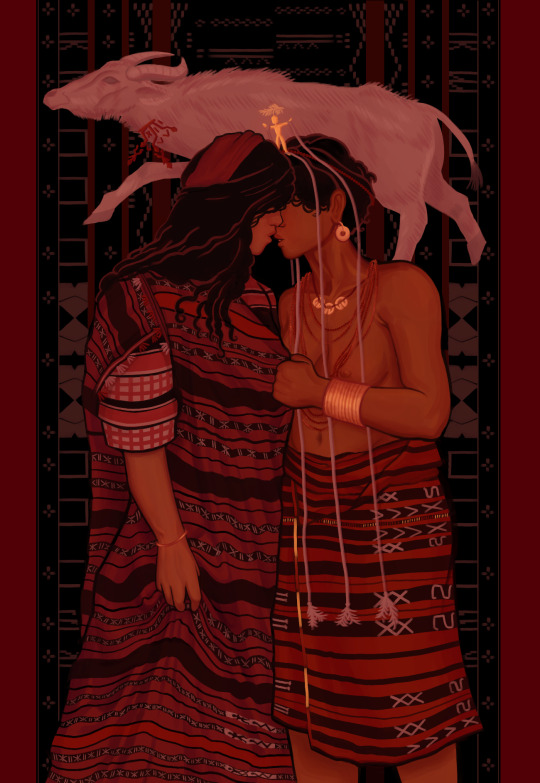
hay naminhod kun he-a ya maid di kiingngohana (my love for you is beyond comparison)
happy international lesbian day <3
[mlm version]
#igorot#ifugao#ibaloi#philippines#filipino#artph#indigenous#gay#lgbt#lesbian#wlw#sapphic#digital art#original art#original characters#artists on tumblr#bare chest /#animal death /#mankadavi#2023#with id#companion piece to my gay mlm igorots drawing! will post together later :)#1k
2K notes
·
View notes
Note
Hi! Do you know any books by Indigenous authors from the archipelago rather than Filipino ppl researching or writing about them (acknowledging all these terms are fraught)
Chiva: A Reader on Ibaloy History and Culture is written by “a combination of professional researchers and non-academics” which includes native perspectives so you might wanna check that out.
anything by june chayapan prill-brett; she is half igorot and has been studying bontok societies for a long time. she was featured in the documentary walang rape sa bontoc.
if you want to include bangsamoro authors, who are indigenous to their lands but are not categorized as Indigenous Peoples per se, then you can go for The Rulers of Magindanao in Modern History, 1515–1903: Continuity and Change in a Traditional Realm in the Southern Philippines by datu atty. michael ong mastura. he is chinese-maguindanaoan and one of the (many, many) descendants of sultan kudarat.
this one i haven’t read but i’d also keep an eye out for Transfiguring Mindanao: A Mindanao Reader, which may include lumad or moro authors.
150 notes
·
View notes
Text
infopost ✨
hello!!! 💕 my name is fen (they/them), im a 28 year old hobby artist based in naarm (melbourne) australia. im poc (filipino/ibaloi) and queer. i like history and video games and bugs! :>
read more for commission and storefront info 🌼
commission info (COMMISSIONS OPEN!)
https://saturnids.carrd.co/ (more detailed info + terms and conditions + examples here!) feel free to dm me if you have any questions or requests






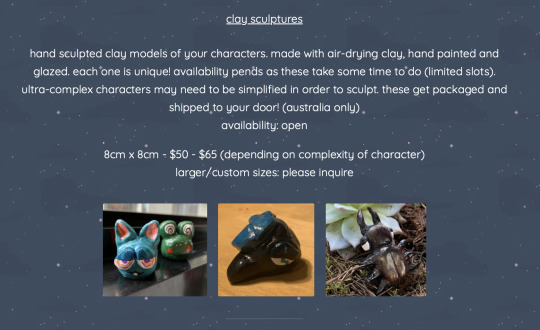
storefront ☘️
i sell prints, stickers, sculptures and heaps more on my storefront on independent artist collective @mushroomyhouse
https://mushroomy.house/collections/saturnids

i also sell upcycled custom toys!
https://mushroomy.house/collections/saturnids-refurbish-friendshop

#digital art#my art#illustration#store#indie artist#tarot commissions#commission work#commision info
20 notes
·
View notes
Note
Hi Cat I hope you're having a good day! I'm looking for a female fc who is between 21-30 who has spoken up for Palestine who can play a superhero, please? thanks so much for your time <3
Mina El Hammani (1993) Moroccan.
Raveena Aurora (1993) Punjabi Indian - is pansexual.
Devery Jacobs (1993) Mohawk - is queer.
Sinem Ünsal (1993) Turkish.
Ebru Şahin Osman (1994) Turkish.
Asia Jackson (1994) Ibaloi Filipino and African American.
Hager Ahmed (1994) Egyptian.
Nemahsis (1994) Palestinian.
Rose Williams (1994)
Jasmin Savoy Brown (1994) African-American / White - is queer.
Little Simz (1994) Yoruba Nigerian.
Ahsen Eroğlu (1994) Turkish.
Huda Elmufti (1994) Egyptian.
Bruna Marquezine (1995) Brazilian.
Juliette Motamed (1995) Iranian.
Jessica Darrow (1995) Cuban - is a lesbian.
Hannah Dodd (1995)
Gazini Ganados (1995) Palestinian and Bisaya Filipino.
Luca Hollestelle (1996)
Myha'la (1996) Afro Jamaican / White - is queer.
Josefine Frida Pettersen (1996)
Florence Pugh (1996) - resources in Hawkeye.
Jessie Mei Li (1995) Hongkonger / English - is a gender non-conforming woman who uses she/they.
Grace Van Dien (1996)
Lauren Jauregui (1996) Cuban [Spanish, possibly other], likely some Basque - is bisexual.
Thea Sofie Loch Naess (1996)
Tavi Gevinson (1996) Ashkenazi Jewish / Norwegian [converted to Judaism].
Zara Larsson (1997)
Alisha Boe (1997) Somali / White.
Melis Sezen (1997) Turkish.
Alison Oliver (1997) - donated an auction to Cinema4Gaza.
Bahar Şahin (1997) Turkish.
Lori Harvey (1997) African-American.
Sisi Stringer (1997) African Australian.
Piper Curda (1997) Korean / English, Scottish - is apsec.
Iman Meskini (1997) Tunisian / White.
Janella Salvador (1998) Bisaya Filipino.
Esmeralda Soto (1998) Mexican.
May Elghety (1998) Egyptian.
Ethel Cain (1998) - is a trans bisexual and autistic woman.
Joanna Arida (1998) Jordadian.
Benedetta Porcaroli (1998)
Isabella Gomez (1998) Colombian.
Angel Guardian (1998) Palestinian and Filipino.
Máiréad Tyers (1998)
Jessica Alexander (1999)
Kenna Sharp (1999) - is queer.
Samara Joy (1999) African-American.
Sherry-Lee Watson (1999) Arrernte.
Noor Taher (1999) Palestinian and Lebanese.
Sab Zada (1999) Chinese, Filipino, and Hispanic.
Anthony Lexa (2000) - is a trans woman.
Marissa Bode (2000) African-American - is disabled.
Maisie Peters (2000)
Odessa A'zion (2000) Ashkenazi Jewish, English, some Irish, Northern Irish, Welsh, German.
Reneé Rapp (2000) - is a lesbian.
Nazlı Çetin (2000) Turkish.
Cat Burns (2000) Liberian - is queer, autistic and has ADHD.
Frida Argento (2000)
Andria Tayeh (2001) Jordanian and Lebanese.
Freya Allan (2001)
Rachel Zegler (2001) Colombian / White.
Amybeth Mcnulty (2001)
Nora Dari (2001) Moroccan-Belgian.
Maitreyi Ramakrishnan (2001) Tamil.
Asena Keskinci (2001) Turkish.
Kei Kurosawa (2001) Bisaya Filipino and Japanese.
Rhea Norwood (2001) - has type 1 diabetes.
Asher Yasbincek (2001/2002)
Denise Julia (2002) Filipino - is pansexual.
Yara Mustafa (2002) Jordanian.
Jenna Ortega (2002) Mexican and Puerto Rican.
Hope this helps!
6 notes
·
View notes
Text
A Whole New Chapter
Road Trip!
Day 10, Banaue, Ifugao Province
It's a 211 km, 6-hour drive from Tuguegarao to Banaue. The first half of the drive was fine, a pretty straight but rather bumpy road through the Cagayan valley into the foothills. The last half was the curviest road ever. Nonstop turns as we ascended into the highest mountains on Luzon. And I mean nonstop. I think if you put all the straight sections in the last 100 km together you’d have maybe 1 km total of straight road. Think Lombard Street. 100 km of Lombard Street. To make things worse, we were confronted at least once every kilometer with earth and rock slides, and possibly cleanup crews trying to keep ahead of the mess. Constantly down to one lane. Waterfalls coming down the sides of the mountains, onto or under the roadway, sometimes washing out a lane.
The 2-lane road clings to the mountainsides, with one side going vertically upwards, and the other, well you just don’t want to look. Numerous villages, people, and animals also cling to the steep mountains, making the drive even more exciting. With no place to park other than the shoulder-less roadway, it’s pretty much down to taking turns at uncontrolled one-way traffic through the villages. Somehow you make it through. By the time we got here my arms hurt from all the turns. Oh wait… I wasn’t even driving. I pity our driver!
Farmers utilize the land as they can. Can you imagine working this field?

Why make this arduous trek to Banaue? Banaue is considered a must-see heritage site in the Philippines, for its ancient rice terraces. As much as 2000 years ago, the ancestors of the indigenous Igorot people began carving terraces into the steep hillsides to grow rice; they also built an elaborate irrigation system to collect water coming from the mountains and distribute it among the terraces. The terraces are still maintained and used for rice and vegetable cultivation today. Below are views from our hotel room.


An aside - Road Hazards
Spending so much time on the rural roads you see some interesting (i.e., dangerous) sights. Here are a few of my favorite road hazards from this trip.
Two in one. Trikes are a hazard in themselves, turning in front of you with no warning, driving at night with no lights, going 20 km/h and never pulling over. That’s compounded in a rice-growing region. Newly-harvested rice needs to be dried, right? What better place to do that than right on the highway!

Landslides. These were frequent on the road to Banaue. Not sure if these, or the crews trying to clean them up, posed more of a hazard.

And just not sure what to say about this jeepney...

Days 11-12, Baguio, Benguet Province
During Spanish rule, the area now known as Baguio was organized as a “rancheria” consisting of about 20 houses, populated by Ibaloi people. Their name for the area was “Bag-iw”, their term for the moss that grows abundantly in the cool climate. The Spanish corrupted the name into “Baguio”. Following the Spanish-American war, the area was ‘expropriated’ from the Ibaloi who were forced to move, when the American governor of the Philippines territory wanted a cooler place than Manila to locate the capital during the hot summer months. In 1903 President Theodore Roosevelt signed an executive order setting aside the area as a military reservation, and by 1904 a master design for the city by architect Daniel Burnham was completed. The army “hill base” Camp John Hay was established, and soon features such as a mansion for the governor and a manor to be used for U.S. Army officer’s R&R were built. The mansion today is a museum; the Manor is still used as an upscale hotel (pulling up an old one, see “Mark and Georgia’s 2018 Philippines Trip”, days 20-22). Baguio is one of the most popular vacation spots in the Philippines for Filipinos and many international travelers. It’s just a 5-hour drive or a short flight from Manila so makes a feasible weekend escape from the heat – at over 1500 meters (5000 feet) elevation, we saw daytime highs of 22°C (72°F), pleasant indeed!
The drive from Banaue was another 7-hour, 200+ kilometers, pretty easy at first as we descended back into the Cagayan Valley (rice, rice, more rice, and lots of moo moo cows which Max liked). Rice is planted by hand here, one seedling at a time.

At the head of the valley we again drove on twisty 2-lane roads up into the misty pine-covered mountains, once again a 100 km Lombard Street. Did I say “pine-covered”? Have we been mysteriously transported back to California? No, the area around Baguio is noted for its pine trees (Pinus Kesiya, the most common pine species found in Asia). They are rather tall too, though not quite as tall as those around Graeagle.
We wanted a nice end to our road trip, so booked a couple days in a very nice and Max-friendly hotel. Within walking distance of our hotel is Mines View Park. There are no mines to view any more, but it does offer nice views of Baguio. Here’s Max and Georgia getting to know some elderly Igorot ladies in their colorful dress.

We took Max for a walk in Burnham park (remember the architect Burnham), a large mid-city park with a lake full of swan boats. The park was packed with holiday crowds; it was the Philippines Independence Day!


With its cool climate, Baguio is known for growing cool-weather crops, including lettuce, cauliflower, broccoli, cabbage, and strawberries. Nearby Burnham Park is the Baguio Public Market, a huge venue, easy to get lost in, with hundreds of stalls selling local produce. We bought various fresh veggies to bring back home with us, and Georgia also wanted to get some local red rice. Unless you’re Filipino you probably think there are maybe 3-4 kinds of rice… guess again. Even “Dog Rice”!

That wraps up our 2024 road trip, 13 days and a lot of miles. I haven’t added up how many miles – I’ll do that and also find a good map onto which I can plot our course.
Max (have Wubba will travel) is ready to hit the road again!

2 notes
·
View notes